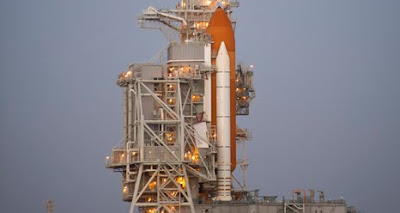Overnight, crews removed
space shuttle Discovery’s ground umbilical carrier assembly, or GUCA, which includes the flight seal, the 7-inch quick disconnect, or QD and the carrier plate, known as the GUCP, as they continue working to investigate the leak.
Teams performed an initial inspection of the
flight seal and quick disconnect prior to sending them to labs for a thorough inspection. Data collected from the initial inspections will be evaluated today by the investigation team. Engineering saw some areas of interest that are being further evaluated. Based on this evaluation, crews could be ready to install a new GUCA on Friday.
Also, technicians have removed external tank foam insulation that cracked during initial loading operations for space shuttle Discovery’s launch attempt on Nov. 5. After
foam removal, two cracks were found on a section of the tank’s metal exterior. The cracks were found on the stringer, which is the aluminum strip that forms the section between the Liquid Oxygen tank and the Liquid Hydrogen tank.

Stringers provide structural integrity to the
intertank. The cracks are approximately nine inches long and were found at the top of one of the stringers beneath the area of foam that cracked during tanking. The cracks in the stringer moved the metal outward sufficiently to dislocate the foam. Engineers are reviewing images of the cracks to determine the best possible repair method, which would be done at
Launch Pad 39A.
The stringers are manufactured using a lighter weight, stronger material of Aluminum Lithium, which was initially incorporated with the Super Light Weight Tank on ET-96 and first flown on STS-91. While the material is stronger and lighter in weight, it is more brittle and has resulted in increased cases of cracked stringers in the areas noted.
The cracked stringer section matches well with the area of foam that cracked, which indicates the stringer crack was the root cause of the foam crack. Analysis shows the intertank has sufficient structural capability for the launch and ascent environments with the cracks in a single stringer. Although the foam was firmly attached to the damaged structure, it is undesirable to launch in this configuration. This area is clearly visible during the pre-launch inspections and would have been detected by the final inspection team.
Crews have repaired similar cracks during external tank production by installing a second piece of aluminum for reinforcement on top of the cracked area before replacing the foam insulation. This piece frequently is referred to as a "
doubler." The repair plan being put into effect is a known one consisting of cutting out the cracked section and replacing it with an available piece that matches its size. A doubler will be inserted before the mounting rivets to complete the repair.
BX foam then will be formed over the newly repaired stringer and will require about four days to cure.Exact schedules and repair options still are being evaluated. Engineers will meet Friday to discuss the status of the three repair activities underway, the external tank stringer and foam repair, the ground umbilical carrier plate and the cockpit panel L4 removal and replacement.
 Metrics from the webcam's hosting platform, Ustream, showed more than one million unique viewers spent more than 400,000 hours watching Curiosity Cam between Oct. 21 and Nov. 23. There have been more than 2.3 million viewer sessions.
Metrics from the webcam's hosting platform, Ustream, showed more than one million unique viewers spent more than 400,000 hours watching Curiosity Cam between Oct. 21 and Nov. 23. There have been more than 2.3 million viewer sessions.


























